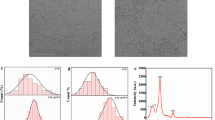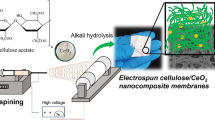Abstract
Cellulose acetate (CA) composite nanofibrous membranes were electrospun by introducing carboxylated cellulose nanocrystals (CCNCs) as organic nanoreinforcements which were prepared by firstly extracting the cellulose nanocrystals from microcrystal celluloses with hydrochloric acid under hydrothermal condition, and followed by oxidization with ammonium persulfate at different temperatures. The influences of the degree of carboxylation and particle size of the CCNCs on the morphology, chemical structure, thermal stability and mechanical properties of as-prepared CA composite nanofibrous membranes were investigated by scanning electron microscopy, Fourier-transform infrared spectroscopy, wide angle X-ray diffraction analysis, thermogravimetric analysis and mechanical test. Furthermore, contact angle measurement and drug release test were used to evaluate the feasibility of these nanofibrous membranes as a sustained release drug delivery system. It is found that due to the incorporation of the CCNCs, remarkable improvements on the thermal stability and mechanical properties as well as drug delivery behavior of CA nanofibrous membrane could be achieved. Especially for the CCNCs prepared at 75 °C, a long-term sustained drug delivery property with a maximum drug release content of 94% within 420 h could be obtained, benefiting from the strong hydrogen bonding between CCNCs and CA matrix, high chain orientation of CA and microstructure of nanofibrous membranes. Therefore, this kind of totally cellulose-based nanofibrous membranes would possess great potential as promising materials for controlled drug delivery applications.








Similar content being viewed by others
References
Adepu S, Gaydhane MK, Kakunuri M, Sharma CS, Khandelwal M, Eichhorn SJ (2017) Effect of micropatterning induced surface hydrophobicity on drug release from electrospun cellulose acetate nanofibers. Appl Surf Sci 426:755–762
Akhlaghi SP, Berry RC, Tam KC (2013) Surface modification of cellulose nanocrystal with chitosan oligosaccharide for drug delivery applications. Cellulose 20(4):1747–1764
Atila D, Keskin D, Tezcaner A (2015) Cellulose acetate based 3–dimensional electrospun scaffolds for skin tissue engineering applications. Carbohydr Polym 133:251–261
Camarero Espinosa S, Kuhnt T, Foster EJ, Weder C (2013) Isolation of thermally stable cellulose nanocrystals by phosphoric acid hydrolysis. Biomacromolecules 14(4):1223–1230
Castro-Guerrero CF, Gray DG (2014) Chiral nematic phase formation by aqueous suspensions of cellulose nanocrystals prepared by oxidation with ammonium persulfate. Cellulose 21(4):2567–2577
Cheng M, Qin Z, Liu Y, Qin Y, Li T, Chen L, Zhu M (2014) Efficient extraction of carboxylated spherical cellulose nanocrystals with narrow distribution through hydrolysis of lyocell fibers by using ammonium persulfate as an oxidant. J Mater Chem A 2(1):251–258
Cheng M, Qin Z, Hu S, Yu H, Zhu M (2017) Use of electrospinning to directly fabricate three-dimensional nanofiber stacks of cellulose acetate under high relative humidity condition. Cellulose 24(1):219–229
Domingues RM, Gomes ME, Reis RL (2014) The potential of cellulose nanocrystals in tissue engineering strategies. Biomacromolecules 15(7):2327–2346
Gouda M, Hebeish AA, Aljafari AI (2014) Synthesis and characterization of novel drug delivery system based on cellulose acetate electrospun nanofiber mats. J Ind Text 43(3):319–329
Greish YE, Meetani MA, Matroushi EAA, Shamsi BA (2010) Effects of thermal and chemical treatments on the structural stability of cellulose acetate nanofibers. Carbohydr Polym 82(3):569–577
Hu X, Liu S, Zhou G, Huang Y, **e Z, **g X (2014) Electrospinning of polymeric nanofibers for drug delivery applications. J Controll Release 185(27):12–21
Jia B, Li Y, Yang B, **ao D, Zhang S, Rajulu A, Kondo T, Zhang L, Zhou P (2013) Effect of microcrystal cellulose and cellulose whisker on biocompatibility of cellulose–based electrospun scaffolds. Cellulose 20(4):1911–1923
Jiang H, Wu Y, Han B, Zhang Y (2017) Effect of oxidation time on the properties of cellulose nanocrystals from hybrid poplar residues using the ammonium persulfate. Carbohydr Polym 174:291–298
Kolakovic R, Peltonen L, Laukkanen A, Hirvonen J, Laaksonen T (2012) Nanofibrillar cellulose films for controlled drug delivery. Eur J Pharm Biopharm 82(2):308–315
Konwarh R, Karak N, Misra M (2013) Electrospun cellulose acetate nanofibers: The present status and gamut of biotechnological applications. Biotechnol Adv 31(4):421–437
Kumar V, Yang T (2002) HNO3/H3PO4–NaNO2 mediated oxidation of cellulose-preparation and characterization of bioabsorbable oxidized celluloses in high yields and with different levels of oxidation. Carbohydr Polym 48(4):403–412
Leung AC, Hrapovic S, Lam E, Liu Y, Male KB, Mahmoud KA, Luong J (2011) Characteristics and properties of carboxylated cellulose nanocrystals prepared from a novel one-step procedure. Small 7(3):302–305
Lu P, Hsieh YL (2010) Preparation and properties of cellulose nanocrystals: rods, spheres, and network carbohydrate. Polymers 82(2):329–336
Luo Y, Wang S, Shen M, Qi R, Fang Y, Guo R, Cai HD, Cao XY, Tomásd H, Zhu MF, Shi XY (2013) Carbon nanotube-incorporated multilayered cellulose acetate nanofibers for tissue engineering applications. Carbohydr Polym 91(1):419–427
Mascheroni E, Rampazzo R, Ortenzi MA, Piva G, Bonetti S, Piergiovanni L (2016) Comparison of cellulose nanocrystals obtained by sulfuric acid hydrolysis and ammonium persulfate, to be used as coating on flexible food-packaging materials. Cellulose 23(1):779–793
Naseri N, Mathew AP, Oksman K (2016) Electrospinnability of bionanocomposites with high nanocrystal loadings: the effect of nanocrystal surface characteristics. Carbohydr Polym 147:464–472
Peresin MS, Habibi Y, Zoppe JO, Pawlak JJ, Rojas OJ (2010) Nanofiber composites of polyvinyl alcohol and cellulose nanocrystals: manufacture and characterization. Biomacromolecules 11(3):674–681
Reid MS, Villalobos M, Cranston ED (2016) Benchmarking cellulose nanocrystals: from the laboratory to industrial production. Langmuir 3(7):1583–1598
Sun C, Boluk Y, Ayranci C (2015) Investigation of nanofiber nonwoven meshes produced by electrospinning of cellulose nanocrystal suspensions in cellulose acetate solutions. Cellulose 22(4):2457–2470
Suwantong O, Opanasopit P, Ruktanonchai U, Supaphol P (2007) Electrospun cellulose acetate fiber mats containing curcumin and release characteristic of the herbal substance. Polymer 48(26):7546–7557
Suwantong O, Ruktanonchai U, Supaphol P (2008) Electrospun cellulose acetate fiber mats containing asiaticoside or centella asiatica crude extract and the release characteristics of asiaticoside. Polymer 49(19):4239–4247
Taepaiboon P, Rungsardthong U, Supaphol P (2007) Vitamin-loaded electrospun cellulose acetate nanofiber mats as transdermal and dermal therapeutic agents of vitamin A acid and vitamin E. Eur J Pharm Biopharm 67(2):387–397
Tang J, Sisler J, Grishkewich N, Tam KC (2017) Functionalization of cellulose nanocrystals for advanced applications. J Colloid Interface Sci 494:397–409
Thenmozhi S, Dharmaraj N, Kadirvelu K, Kim HY (2017) Electrospun nanofibers: new generation materials for advanced applications. Mater Sci Eng B 217:36–48
Tungprapa S, Jangchud I, Supaphol P (2007a) Release characteristics of four model drugs from drug-loaded electrospun cellulose acetate fiber mats. Polymer 48(17):5030–5041
Tungprapa S, Puangparn T, Weerasombut M, Jangchud I, Fakum P, Semongkhol S, Chidchanok M, Supaphol P (2007b) Electrospun cellulose acetate fibers: effect of solvent system on morphology and fiber diameter. Cellulose 14(6):563–575
Um-i-Zahra S, Shen XX, Li H, Zhu L (2014) Study of sustained release drug-loaded nanofibers of cellulose acetate and ethyl cellulose polymer blends prepared by electrospinning and their in-vitro drug release profiles. J Polym Res 21(12):602-1-12
Vallejos ME, Peresin MS, Rojas OJ (2012) All-cellulose composite fibers obtained by electrospinning dispersions of cellulose acetate and cellulose nanocrystals. J Polym Environ 20(4):1075–1083
Wu XM, Branford-White CJ, Zhu LM, Chatterton NP, Yu DG (2010) Ester prodrug-loaded electrospun cellulose acetate fiber mats as transdermal drug delivery systems. J Mater Sci 21(8):2403–2411
Yang ZY, Wang WJ, Shao ZQ, Zhu HD, Li YH, Wang FJ (2013) The transparency and mechanical properties of cellulose acetate nanocomposites using cellulose nanowhiskers as fillers. Cellulose 20(1):159–168
Yang W, Sousa AM, Fan X, ** T, Li X, Tomasula PM, Liu LS (2017) Electrospun ultra-fine cellulose acetate fibrous mats containing tannic acid-Fe3+ complexes. Carbohydr Polym 157:1173–1179
Yu DG, Li XY, Wang X, Wei C, Liao YZ, Li Y (2013a) Zero-order drug release cellulose acetate nanofibers prepared using coaxial electrospinning. Cellulose 20(1):379–389
Yu H, Qin Z, Liang B, Liu N, Zhou Z, Chen L (2013b) Facile extraction of thermally stable cellulose nanocrystals with a high yield of 93% through hydrochloric acid hydrolysis under hydrothermal conditions. J Mater Chem A 1(12):3938–3944
Zhang K, Sun P, Liu H, Shang S, Song J, Wang D (2016) Extraction and comparison of carboxylated cellulose nanocrystals from bleached sugarcane bagasse pulp using two different oxidation methods. Carbohydr Res 138:237–243
Acknowledgments
This work has been financially supported by Program for Innovative Research Team in University of Ministry of Education of China (IRT_16R13), Key Basic Research Project of Science and Technology of Shanghai (15Q10622), and the National College Students’ Innovative Training Program (201510255056).
Author information
Authors and Affiliations
Corresponding authors
Rights and permissions
About this article
Cite this article
Hu, S., Qin, Z., Cheng, M. et al. Improved properties and drug delivery behaviors of electrospun cellulose acetate nanofibrous membranes by introducing carboxylated cellulose nanocrystals. Cellulose 25, 1883–1898 (2018). https://doi.org/10.1007/s10570-018-1662-1
Received:
Accepted:
Published:
Issue Date:
DOI: https://doi.org/10.1007/s10570-018-1662-1




